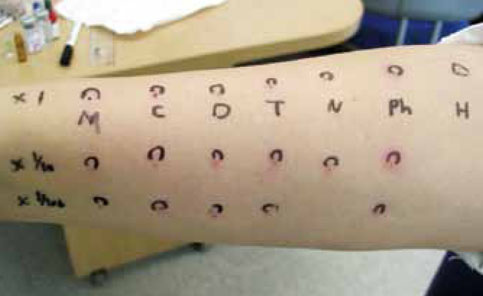Allergy Asthma Immunol Res.
2011 Jan;3(1):62-64. 10.4168/aair.2011.3.1.62.
A Case of Chlorpheniramine Maleate-Induced Hypersensitivity With Aspirin Intolerance
- Affiliations
-
- 1Department of Internal Medicine, Seoul National University College of Medicine, Seoul, Korea. addchang@sun.ac.kr
- 2Institute of Allergy and Clinical Immunology, Seoul National University Medical Research Center, Seoul, Korea.
- 3Department of Internal Medicine, Seoul National University Bundang Hospital, Seongnam, Korea.
- 4Department of Internal Medicine, Armed Forces Capital Hospital, Seongnam, Korea.
- KMID: 2260380
- DOI: http://doi.org/10.4168/aair.2011.3.1.62
Abstract
- Antihistamines are commonly used to treat allergic disease, such as allergic rhinitis, urticaria, and angioedema. Although several previous reports describe hypersensitivity to antihistamines such as cetirizine and hydroxyzine, documented cases of chlorpheniramine hypersensitivity are extremely rare. Here, we report the case of a 45-year-old Korean woman who presented with urticaria after ingesting a cold medication. Over the previous 5 years, she had also experienced a food allergy to crab and shrimp, allergic rhinitis, and repeated urticaria after ingesting cold medication. Provocation with aspirin elicited generalized urticaria. Intravenous chlorpheniramine and methylprednisolone was injected for symptom control, but in fact appeared to aggravate urticaria. A second round of skin and provocation tests for chlorpheniramine and methylprednisolone showed positive results only for chlorpheniramine. She was diagnosed with aspirin intolerance and chlorpheniramine hypersensitivity, and was instructed to avoid these drugs. To date, this is the second of only two cases of chlorpheniramine-induced type I hypersensitivity with aspirin intolerance. Although the relationship between aspirin intolerance and chlorpheniramine-induced type I hypersensitivity is unclear, physicians should be aware of the possibility of urticaria or other allergic reactions in response to antihistamines.
MeSH Terms
-
Angioedema
Aspirin
Cetirizine
Chlorpheniramine
Cold Temperature
Drug Hypersensitivity
Female
Food Hypersensitivity
Histamine Antagonists
Humans
Hydroxyzine
Hypersensitivity
Hypersensitivity, Immediate
Methylprednisolone
Middle Aged
Rhinitis
Rhinitis, Allergic, Perennial
Skin
Urticaria
Aspirin
Cetirizine
Chlorpheniramine
Histamine Antagonists
Hydroxyzine
Methylprednisolone
Figure
Cited by 3 articles
-
Anaphylaxis to Chlorpheniramine Maleate and Literature Review
Yong Won Choi, Min Je Jung, Hye One Kim, Bo Young Chung, Chun Wook Park
Ann Dermatol. 2019;31(4):438-441. doi: 10.5021/ad.2019.31.4.438.Drug hypersensitivity to various antihistamines with cross-reactions
Young Uck Kim, Jaechun Lee
Allergy Asthma Respir Dis. 2014;2(2):134-137. doi: 10.4168/aard.2014.2.2.134.Chlorpheniramine-induced anaphylaxis diagnosed by basophil activation test
Hyun-Seung Lee, Woo-Jung Song, Ji-Won Lee, Young-Yoon Cho, Han-Ki Park, Min-Gyu Kang, Sang-Heon Cho, Seong-Wook Sohn
Asia Pac Allergy. 2015;5(3):177-180. doi: 10.5415/apallergy.2015.5.3.177.
Reference
-
1. Holgate ST, Church MK, Lichtenstein LM. Allergy. 2006. 3rd ed. Philadelphia: Mosby Elsevier.2. Grammer LC, Greenberger PA. Patterson's allergic diseases. 2009. 7th ed. Philadelphia: Lippincott Williams & Wilkins.3. Inomata N, Tatewaki S, Ikezawa Z. Multiple H1-antihistamine-induced urticaria. J Dermatol. 2009; 36:224–227.4. Cravo M, Goncalo M, Figueiredo A. Fixed drug eruption to cetirizine with positive lesional patch tests to the three piperazine derivatives. Int J Dermatol. 2007; 46:760–762.5. Mahajan VK, Sharma NL, Sharma VC. Fixed drug eruption: a novel side-effect of levocetirizine. Int J Dermatol. 2005; 44:796–798.6. Lew BL, Haw CR, Lee MH. Cutaneous drug eruption from cetirizine and hydroxyzine. J Am Acad Dermatol. 2004; 50:953–956.7. Cáceres Calle O, Fernández-Benítez M. Allergy to dexchlorpheniramine. Study of a case. Allergol Immunopathol (Madr). 2004; 32:306–309.8. Demoly P, Messaad D, Benahmed S, Sahla H, Bousquet J. Hypersensitivity to H1-antihistamines. Allergy. 2000; 55:679–680.9. Thurot-Guillou C, Bourrain JL, Jacquier JP, Beani JC. Anaphylactic reaction to ranitidine and dexchlorpheniramine. Eur J Dermatol. 2007; 17:170–171.10. Lee SH, Jung HS, Yoon TY, Chang EJ, Kim MK, Kim KS. Allergic reaction to chlorpheniramine in a patient with aspirin-intolerant asthma. Korean J Asthma Allergy Clin Immunol. 2010; 30:55–58.11. Harada S, Horikawa T, Ashida M, Kamo T, Nishioka E, Ichihashi M. Aspirin enhances the induction of type I allergic symptoms when combined with food and exercise in patients with food-dependent exercise-induced anaphylaxis. Br J Dermatol. 2001; 145:336–339.12. Chang YS, Kwon HS, Cho SH, Kim YY, Min KU. A case of urticaria induced by both hydroxyzine and cetirizine but not by levocetirizine. Allergy. 2007; 62:819–821.
- Full Text Links
- Actions
-
Cited
- CITED
-
- Close
- Share
- Similar articles
-
- Anaphylaxis to Chlorpheniramine Maleate and Literature Review
- Allergic Reaction to Chlorpheniramine in a Patient with Aspirin-Intolerant Asthma
- The Effect of H1-Receptor Antagonist on Hemodynamic Change during Anesthesia
- A Case of Anaphylaxis Induced by Oral Cefaclor in Aspirin Idiosyncratic Patient
- A case of acetaminophen induced bronchial asthma without aspirin sensitivity


